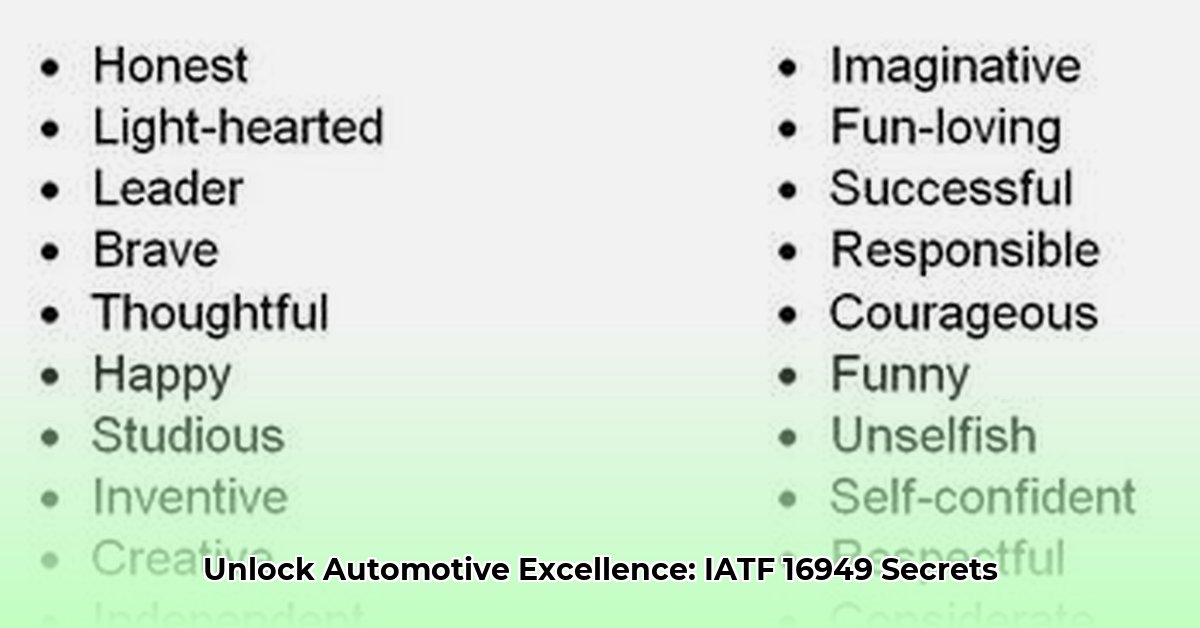Navigating the Complexities of Special Characteristics in Automotive Manufacturing
In the demanding world of automotive manufacturing, precision and quality are paramount. Special characteristics (SCs), those critical features impacting safety, compliance, and functionality, demand rigorous management. This guide provides a practical roadmap for navigating the complexities of IATF 16949’s SC requirements, empowering your organization to achieve and maintain automotive excellence. Failing to address these critical elements can have significant repercussions, jeopardizing both safety and your company’s reputation. For more on data management best practices, see this helpful resource on managing information.
Identifying Special Characteristics: A Multifaceted Approach
Identifying SCs requires a holistic approach, moving beyond mere compliance to a deep understanding of your product and process. This crucial step involves a multi-layered investigation to ensure no critical detail is overlooked.
Deconstructing Customer Requirements: Begin by meticulously dissecting customer specifications and engineering drawings. These documents often explicitly define SCs, providing a clear starting point for your analysis. Look for symbols and annotations that highlight critical features. What are your customers’ absolute must-haves? Are there implied requirements that need to be clarified?
Proactive Internal Risk Assessment: Conduct a comprehensive risk analysis using tools like Failure Mode and Effects Analysis (FMEA). This proactive approach identifies potential failure modes and their impact, allowing you to pinpoint SCs beyond those explicitly defined by the customer. Consider potential process variations, material inconsistencies, and environmental factors. What could go wrong within your operations, and how severe would the consequences be?
Harnessing Cross-Functional Expertise: Assemble a team representing all relevant disciplines: design, engineering, manufacturing, quality, purchasing, and even customer service. This collaborative approach ensures a 360-degree perspective, uncovering potential SCs that might be missed by a single department. Leverage the diverse knowledge base to identify potential weaknesses and ensure comprehensive coverage.
Documenting with Precision: Maintain meticulous documentation of all identified SCs. This includes not only the characteristic itself but also its classification (critical or significant), the rationale for its designation, the associated control plan, and the responsible parties. Clear, concise documentation ensures everyone operates from the same playbook, minimizing confusion and ambiguity. Utilize a standardized format for consistency and easy retrieval. Is your documentation system readily accessible and regularly updated?
Categorizing Special Characteristics: Critical vs. Significant
SCs are broadly categorized as critical or significant, each requiring a tailored approach to management. Understanding this distinction is crucial for effective risk mitigation and resource allocation.
Critical Characteristics (CCs): Representing the highest level of concern, CCs directly impact safety, regulatory compliance, or environmental regulations. Examples include airbag deployment parameters, brake system performance, and emissions control systems. CCs demand stringent controls, rigorous testing, and meticulous record-keeping, often requiring retention for 15 years or more due to legal and regulatory obligations. What aspects of your product or process absolutely must perform flawlessly to prevent serious harm or legal repercussions?
Significant Characteristics (SCs): While not directly related to safety or compliance, SCs impact customer satisfaction, product functionality, performance, or subsequent processing. Examples include dimensional tolerances, surface finishes, and aesthetic attributes. SCs require robust controls and monitoring but typically do not necessitate the same level of scrutiny as CCs. What features influence customer perception, product usability, and downstream processes?
Implementing Robust Control Plans: Guaranteeing Consistent Quality
Once SCs are identified and categorized, robust control plans are essential for ensuring consistent quality and preventing defects. These plans should be detailed, actionable, and readily available to those responsible for implementation.
Implementing Precise Measurement Systems: Define specific measurement methods, equipment, and calibration procedures for each SC. Accuracy and repeatability are paramount to ensure reliable data. Conduct Measurement System Analysis (MSA) to validate the capability of your measurement system. Does your equipment meet the required accuracy and precision? Is your calibration process documented and consistently followed?
Establishing Clear Acceptance Criteria: Define clear and unambiguous acceptance criteria for each SC. This includes specifying tolerances, limits, and acceptable variations. Ensure that these criteria are aligned with customer requirements and regulatory standards. Are your acceptance criteria clearly communicated and understood by all relevant personnel?
Implementing Proactive Process Controls: Implement proactive process controls to prevent defects and maintain SCs within defined limits. Utilize Statistical Process Control (SPC), error-proofing techniques (poka-yoke), and regular process audits. Establish control limits, reaction plans, and escalation procedures for out-of-control conditions. How are you proactively preventing deviations and ensuring process stability?
Defining Corrective Actions: Establish detailed procedures for addressing deviations and non-conformances related to SCs. These procedures should include root cause analysis, corrective actions, and preventive measures to prevent recurrence. Ensure that corrective actions are timely, effective, and documented. What happens when a deviation occurs? How quickly is it addressed? How do you prevent it from happening again?
Maintaining Meticulous Records: Implement a robust record-keeping system to track SC performance, inspections, measurements, deviations, and corrective actions. This provides a comprehensive audit trail, facilitates data analysis, and supports continuous improvement efforts. Ensure that records are readily retrievable and stored securely. Are your records complete, accurate, and readily accessible? Do they comply with retention requirements?
Monitoring and Continuous Improvement: Maintaining a Competitive Edge
Effective SC management is not a static activity but a dynamic process that requires ongoing monitoring, evaluation, and continuous improvement. This ensures your system adapts to changing conditions and maintains its effectiveness.
Conducting Regular Audits: Perform regular internal audits to assess compliance with control plans, identify weaknesses, and drive continuous improvement. These audits should be conducted by trained personnel and cover all aspects of SC management. Are your processes consistently meeting the defined standards? Where are the gaps, and how can they be closed?
Leveraging Data Analysis: Analyze SC data to identify trends, patterns, and potential problems. Utilize statistical tools and techniques to gain deeper insights into process performance and identify opportunities for optimization. What is your data telling you about the effectiveness of your control plans? Where are the areas for improvement?
Performing Management Reviews: Conduct regular management reviews to evaluate the overall effectiveness of the SC management system. Review performance data, audit findings, and customer feedback to identify areas for improvement and adjust control plans as needed. This ensures your system remains aligned with business objectives and evolving customer requirements. How often are you reviewing and updating your strategies? Are you incorporating lessons learned and best practices?
By diligently applying these principles, your organization can master the complexities of special characteristic management as outlined in IATF 16949. This proactive approach minimizes risks, ensures compliance, enhances customer satisfaction, and positions your company for success in the competitive automotive industry.
- 1 Liter to Fluid Ounces: Easy Conversion Guide - April 9, 2025
- Unlock what is the seventh month: A Cross-Cultural Calendar Guide - April 9, 2025
- Discover White Fruits: Ultimate Guide to Taste & Nutrition - April 8, 2025
















